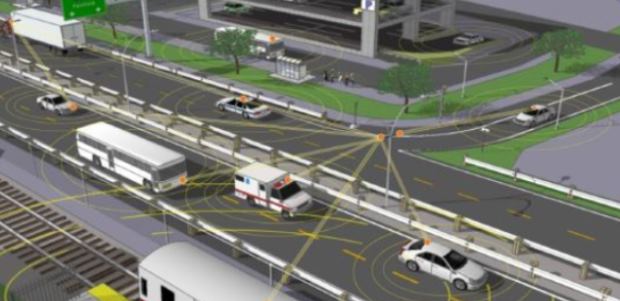
NHTSA Moving Forward with Vehicle-to-Vehicle Technology
An ANPRM and a research report issued this week are about technology that "represents the next great advance in saving lives," Transportation Secretary Anthony Foxx said.
The National Highway Traffic Safety Administration is taking comments on an advance notice of proposed rulemaking that will lead to a new Federal Motor Vehicle Safety Standard, No. 150, requiring vehicle-to-vehicle (V2V) communication capability for new passenger cars and light trucks. NHTSA also wants comments on a related research report titled "Vehicle-to-Vehicle Communications: Readiness of V2V Technology for Application." In the report, NHTSA outlines the results of its initial research and includes a "very preliminary" estimate of the costs of V2V and the benefits for two V2V-based safety applications, Intersection Movement Assist and Left Turn Assist, for addressing intersection crashes and left-turning crashes.
IMA and LTA could prevent up to 592,000 crashes and save 1,083 lives per year, the report estimates, and it describes additional applications that could also help drivers avoid imminent danger by providing forward collision, blind spot, do not pass, and stoplight/stop sign warnings.
The report discusses technical, legal, security, and privacy issues related to the technology's implementation. The agency intends to mandate V2V technology in all new vehicles but not require specific safety applications, out of the belief this will facilitate market-driven R&D and the introduction of a variety of safety applications.
NHTSA is working toward issuing a Notice of Proposed Rulemaking by 2016.
"Safety is our top priority, and V2V technology represents the next great advance in saving lives," said U.S. Transportation Secretary Anthony Foxx. "This technology could move us from helping people survive crashes to helping them avoid crashes altogether – saving lives, saving money, and even saving fuel thanks to the widespread benefits it offers."
"By warning drivers of imminent danger, V2V technology has the potential to dramatically improve highway safety," said NHTSA Deputy Administrator David Friedman. "V2V technology is ready to move toward implementation, and this report highlights the work NHTSA and DOT are doing to bring this technology and its great safety benefits into the nation’s light vehicle fleet."
Information sent between vehicles doesn't identify the vehicles; it merely contains basic safety data, according to NHTSA, which says the system as contemplated contains several layers of security and privacy protection.
The report says NHTSA believes V2V capability won't develop without federal regulation "because there would not be any immediate safety benefits for consumers who are early adopters of V2V. V2V begins to provide safety benefits only if a significant number of vehicles in the fleet are equipped with it and if there is a means to ensure secure and reliable communication between vehicles. NHTSA believes that no single manufacturer would have the incentive to build vehicles able to 'talk' to other vehicles, if there are no other vehicles to talk to – leading to likely market failure without the creation of a mandate to induce collective action."
The report is available at http://www.safercar.gov/v2v, and at http://www.regulations.gov, Docket No. NHTSA-2014-0022.
NHTSA estimates about 5 million vehicle crashes occur annually, causing property damage, injuries, and fatalities. "While it may seem obvious, if technology can help drivers avoid crashes, the damage due to crashes simply never occurs. The agency's push thus far for adoption of crash avoidance technologies, like electronic stability control, has helped vehicles react to crash-imminent situations, but has not yet been able to help the driver react ahead of time," the report says, adding that V2V can help to fill that gap.